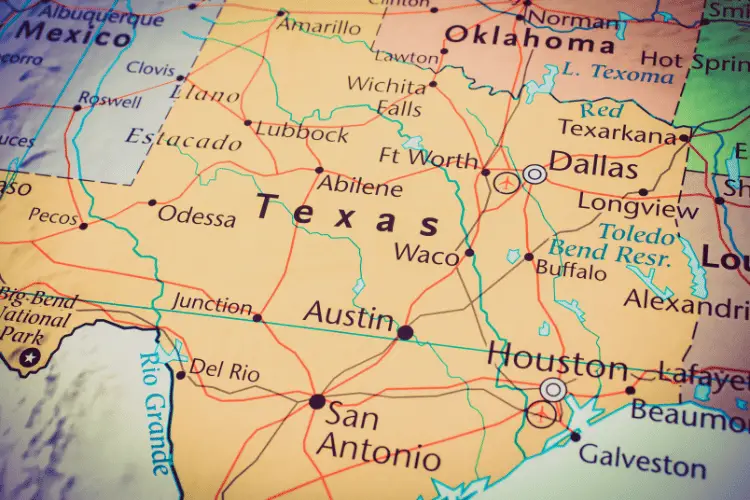We strive to provide you with authoritative, trustworthy, and expert advice. In doing so, the staff at texaswalkabout.com performs extensive research, editing, and fact checking to every post on this webiste. If you feel that this article can improve, please feel free to reach us at staff@texaswalkabout.com
Widely known as The Lone Star State, Texas has had a colorful history. Starting in the early 1500s, it was ruled by Spain, followed by France, then back to Spain.
Then, in the 19th century, Mexico gained control over the territory for about a decade until it was declared the ‘Republic of Texas’ in 1836. Yet, that also didn’t last long.
The United States government soon took over and Texas was declared a state on December 29, 1845.
However, the most interesting tidbit about Texas is that it’s the second biggest state in the US spanning nearly 270,000 square miles.
And we all know what that means: more land means covering a broader range of lines of longitude. In other words, more time zones to cross.
This brings us to today’s topic: Texas time zones. In this post, we’ll discover the history behind time zones and which one The Lone Star State belongs to.
Let’s dive in.
Time Zones: An Overview
Time zones, also referred to as meridians, are 24 imaginary lines that cover the entire globe. They run in a north-south direction with an equal width of 15 degrees.
Each time zone is assigned with one of the 24 hours. Together, they make up one day or one full rotation of the Earth.
A uniform standard time is typically maintained in each time zone to track the day-night cycle. This means everyone in a geographical region within a specific time zone uses the same time.
Greenwich Mean Time
Their starting point is centered on the Prime Meridian at 0 degrees. In the 1850s and 1860s, expansions were taking place in communications and railways.
In 1884, 41 delegates from 25 nations met in Washington, DC to attend the International Meridian Conference. There, the concept of Universal Time (UT) was created, which is the basis for the 24-hour time zone system we’re all familiar with today.
It was also where the delegates chose Greenwich to be the ‘center of world time’ because of its unique geographical location.
Accordingly, the time on every place on Earth is measured in terms of its distance either east or west from Greenwich Mean Time or GMT.
Coordinated Universal Time
On the first of January 1972, Coordinated Universal Time (UTC) was officially put into practice and replaced Greenwich Mean Time as the standard basis for time reference.
Before 1972, GMT, sometimes referred to as Zulu time, was the same as Universal Time.
Nowadays, GMT is no longer the standard. It refers only to the name of one of the 24 time zones used by a handful of Western European countries and even some in Africa.
Instead, time zones in most regions around the world are expressed as either positive or negative offsets from UTC.
While some argue that UTC and GMT are practically the same, the difference is that the former is the unit of the atomic second. Thus, it’s much more accurate as it relies on highly precise atomic clocks combined with Earth’s rotation.
There are two factors that help determine the precise UTC calculations:
- International Atomic Time (TAI): This time scale combines the output of over 400 highly precise atomic clocks around the globe. It’s what provides the exact speed at which our clocks run.
- Universal Time (UT): Sometimes called Solar Time or Astronomical Time, UT refers to the Earth’s rotation. It works alongside TAI to compare the pace of the clocks with the actual length of the day.
Time Zones in the US
Before 1884, railroads were being built to connect cities and towns across the United States. Railroad managers, however, were plagued by the difference in times between them.
To try and fix this problem, they decided to set up 100 different railroad time zones. This resulted in different railroad lines running on different time systems.
In the beginning, it seemed to give the illusion of a cohesive nationwide operation. Still, scheduling all those railroad lines was a laborious task and extremely confusing for everyone involved including the managers, train drivers, and passengers.
Finally, in 1883, railway managers were fed up with all the confusion and decided to discard the idea of using different local time zones. Instead, they came up with the idea of dividing the US into only four time zones: Eastern, Central, Mountain, and Pacific.
Then, at noon on the 18th of November, 1883, the US Naval Observatory ratified the change and the four time zones became official.

A year later, Greenwich Mean Time was put into effect. Quickly, people all over the world could travel and communicate with much less confusion and chaos.
Recently, around the start of the 1980s, the US government added two more time zones: Hawaii-Aleutian (HST) and Alaska Standard Time (AKST).
Texas Is in What Time Zone?
The Lone Star State is made up of 254 counties spread out over an area of approximately 268, 597 square miles. These counties range in population from over 4 million in Harris County to a few hundred in Loving County near the New Mexico border.
Because Texas covers such a large portion of the southern US, it uses two time zones: Central and Mountain.
The majority of the state falls in the Central Time Zone (CST). Also known as Central Standard Time (CST), it’s six hours behind Coordinated Universal Time (UTC) or UTC – 6 h.
Then, when Texas observes Daylight Savings Time, it uses Central Daylight Time (CDT) Zone and is five hours behind UTC.
However, there are a couple of counties in the northwestern region of the state that observe the Mountain Time Zone (MST) and have an offset of UTC – 7 h.
Then, during Daylight Saving Time, these counties use the Mountain Daylight Time (MDT), or UTC – 6 h.
Does Texas Use Central Time?
In winter, the Central Time Zone (CST) is six hours behind UTC, aka UTC – 6 h.
Then, when Daylight Saving Time begins, it becomes known as Central Daylight Time (CDT). During this time, it’s only five hours behind UTC (UTC – 5 h).
10 states are entirely within the CST. Then, there are five that are split between the CST and the Eastern Time Zone, which contains all the states on the east coast.
In addition, there are another five other states that are divided between CST and the Mountain Time Zone.
One of these is Texas, which is almost entirely in the Central Time Zone.
The only exceptions are the two westernmost counties: El Paso and Hudspeth. They fall under the Mountain Time Zone (MST). A few parts of their neighbor, Culberson County, also observe MST.
Is Texas in the Mountain Time Zone?
Yes, as mentioned above, there’s a small part of Texas that falls within the Mountain Time Zone (MST).
These include a handful of counties located in the top western corner of The Lone Star State including El Paso, Hudspeth, and parts of Culberson counties.
All states within MST keep time by subtracting seven hours from Coordinated Universal Time UTC (UTC – 7 h) during winter. Then, when it’s time to switch to Mountain Daylight Time (MDT), it reaches UTC – 6 h.
There are six states that are completely contained in the Mountain Time Zone: Colorado, Montana, New Mexico, Utah, Wyoming, and Arizona.
It’s worth noting that out of these states, Arizona is the only one that doesn’t observe Daylight Saving Time. The only exception is the Navajo Nation in the northeastern portion of Arizona.
MST is also observed in some parts of Idaho, Kansas, Oregon, Nebraska, Nevada, North Dakota, and South Dakota.
Is Texas in the Eastern or Pacific Time Zone?
Located in the mid-section of the United States, Texas doesn’t belong to either the Eastern Time Zone on the east coast or the Pacific Time Zone on the West.
The Eastern Time Zone (EST) is five hours behind Coordinated Universal Time (UTC). It’s one of the most popular time zones around the world because it contains many of the largest and best-known cities in both Canada and the US.
There are 15 states that are fully incorporated in EST. In addition, five states, Florida, Tennessee, Kentucky, Indiana, and Michigan, are divided between EST and the Central Time Zone like most of Texas.
The time zone with the least number of states is the Pacific Time Zone (PST). With an offset of – 8 h and – 7 h during Daylight Saving Time, only California and Washington are fully contained within PST.
Oregon, Nevada, and Idaho are split between PST and Mountain Time. Then you have Alaska, which lies within three time zones: PST, the Alaska Time Zone, and the Hawaii-Aleutian Time Zone.
Time Difference Between Texas and New York
Because New York is in the Eastern Time Zone, it’s always ahead of Texas.
Also, since both states observe Daylight Saving Time, New York is consistently one hour ahead of The Lone Star State.
This applies to the majority of Texas that fall in the Central Time Zone.
As for the Texan counties in the Mountain Time Zone, there’s a two-hour difference. In other words, New York is two hours ahead of El Paso, Hudspeth, and those few parts of Culberson County.
Time Difference Between Texas and Florida

Funny enough, Florida follows a similar pattern when it comes to time zones. Most of the Sunshine State falls in one time zone, Eastern Standard Time (EST). Alternatively, a small northwestern portion of the state falls in another time zone, Central Time Zone (CST).
This means that most of Florida is one hour ahead of the majority of Texas. As for the few counties in Texas that are part of the Mountain Time Zone, they’re always two hours behind most of Florida. However, they’re only one hour behind that small part of Florida that falls in the Central Time Zone.
Also, both states observe Daylight Saving Time, which means the time difference always stays the same throughout the year.
Time Difference Between Texas and Australia
Australia is nicknamed ‘The Land Down Under’ and ‘The Lucky Country’ because of its patriotic and positive sense. Being the sixth largest country in the world, it’s divided into three time zones.
The first is the Australian Eastern Standard Time (AEST), which is UTC + 10 h. The second time zone is the Australian Central Standard Time (ACST), which has an offset of UTC + 9:30 h. The third zone is the Australian Western Standard Time (AWST), which is UTC + 8 h
As such, Australia is 15 hours ahead of the parts of Texas in the Central Time Zone, and ahead of the Mountain Time Zone by 16 hours.
We should mention that since Australia is located in the southern hemisphere, spring begins on September 1. That’s right around the time when Daylight Saving Time is observed in many parts of the country and continues until the following March.
Time Difference Between Texas and New Zealand
By law, New Zealand, or The Land of the Long White Cloud, is divided into two standard time zones. The main islands are in New Zealand Standard Time (NZST), which is 12 hours ahead of Coordinated Universal Time.
On the other hand, the outlying islands, Chatham Islands, use Chatham Standard Time (CHAST), making them 12 hours and 45 minutes ahead of UTC.
This makes the main New Zealand islands ahead of the majority of The Lone Star State within the Central Time Zone by 17 hours. At the same time, it’s 18 hours ahead of the counties that lie in the Mountain Time Zone.
Keep in mind that if you’re traveling to the Chatham Islands, you’ll need to add 45 extra minutes.
It’s worth mentioning that New Zealand, like many parts of Australia, also observes Daylight Saving Time from September to March.
Is Texas Ending Daylight Saving Time?
In the United States, Daylight Saving Time starts on the second Sunday in March at precisely 2 am. It ends on the first Sunday in November also at 2 am.
Out of the 50 states, the only two that don’t observe Daylight Saving Time are Hawaii and Arizona.
This means that Texas observes Daylight Saving Time. During that time, the Central Time Zone is referred to as Central Daylight Time (CDT).
Final Thoughts
Ever since the mid-19th century, time zones have been an integral part of how we connect across the globe. It’s helped us develop communications and transportation systems while allowing us to travel long distances without confusion or fuss.
The main Texas time zone is Central Time, whereas only a small portion of the southern state lies within the bounds of the Mountain Time Zone.

Robert is a native Texan writer for TexasWalkabout, passionate about Texas culture and food, wearing cowboy boots daily. He interviews local pitmasters and chefs, tastes and reviews innovative dishes, and explores hidden gems and iconic landmarks. Graduating magna cum laude in Cyber Security from the University of Texas at San Antonio, Robert excels academically and professionally while also being knowledgeable in Texas history and culture. After living in Texas for over 28 years, he provides first-hand and trustworthy information for all your Texas needs!

